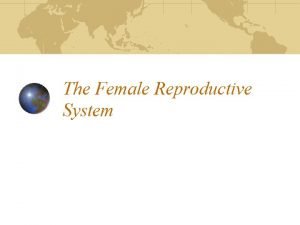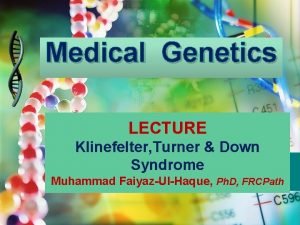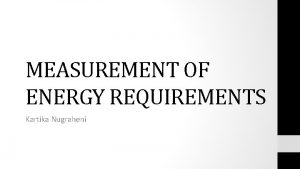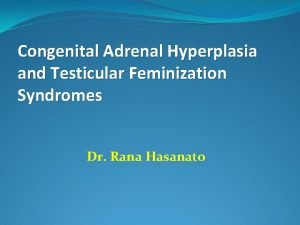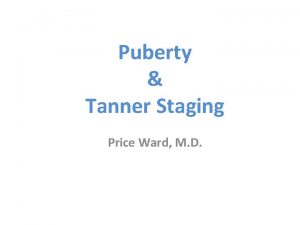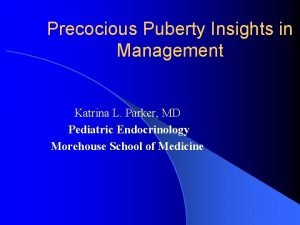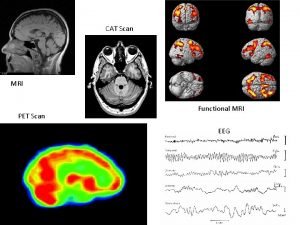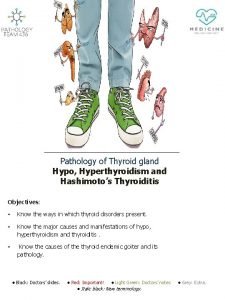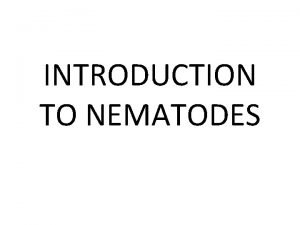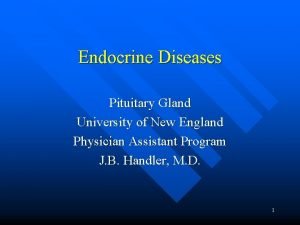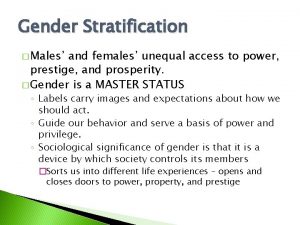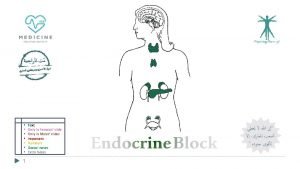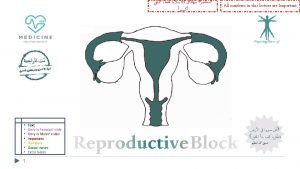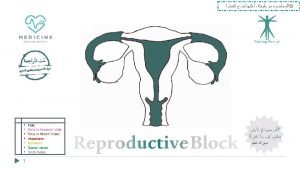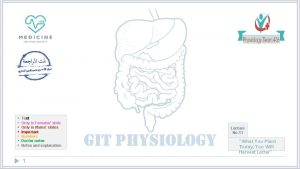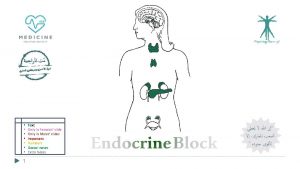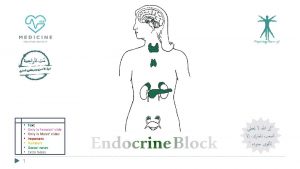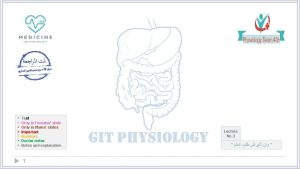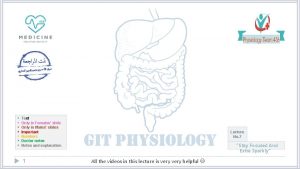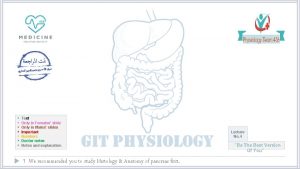1 Text Only in Females slide Only in



















- Slides: 19

§ § § § 1 Text Only in Females’ slide Only in Males’ slides Important Numbers Doctor notes Extra Notes

Hypothalamic & Pituitary Gonadal Axis By the end of this lecture, students should be able to describe: 1. Characterize hypothalamic pituitary relationship. 2. Name the hypophysiotropic hormones and outline the effects that each has on anterior pituitary function. 3. Name anterior pituitary gonadotropic hormones and outline the effects that each has on the gonads. 4. Describe the negative and positive feedback mechanisms in the hypothalamic-pituitarygonadal axis and their importance in the control of reproductive function. 2

Only in Females’ Slides Recall From The Endocrine Block What is a hormone? Chemical substance secreted in a small amount from endocrine gland directly to the blood stream in response to stimulus to cause physiological responses at the target tissues. How hypothalamus controls anterior pituitary? By Connection between Hypothalamus and anterior pituitary gland which is called: “hypothalamichypophysial portal vessels”. There is NO direct neural contact to anterior pituitary. What are the hormones secreted by anterior pituitary? 1. Growth hormone (GH). 2. Thyroid-stimulating hormone (TSH). 3. Adrenocorticotropic hormone (ACTH). 4. Follicle-stimulating hormone (FSH). 5. Luteinizing hormone (LH) also known as lutropin. 6. Prolactin (PRL). 3

Only in Females’ Slides Recall From The Endocrine Block How hypothalamus controls posterior pituitary? By Connection between the hypothalamus and Posterior pituitary gland which is called: “Hypothalamo-hypophysial tract” between the hypothalamic neuclei (supraoptic & paraventricular nuclei) and posterior pituitary gland. There is direct neural contact to anterior pituitary. What are the hormones secreted by posterior pituitary? 1. Oxytocin. 2. ADH 4

Hypothalamic Pituitary Control of Male & Female Reproduction The Hypothalamus: Secretes Gonadotropin releasing hormone (Gn. RH). The Anterior Pituitary gland: Secretes both Lutenizing hormone (LH) & Follicle stimulating hormone (FSH). The Ovaries: secrete Estrogen, Progesterone and Inhibin. The Testis: secrete Testosterone and Inhibin. (Inhibin downregulates FSH synthesis & secretion) We will talk about this in details next slide 5 � Gonadotropin releasing hormone (Gn. RH) is a peptide secreted by the arcuate nuclei of the hypothalamus through the hypothalamichypophysial portal system to the anterior pituitary gland & stimulates the release of gonadotropins (LH and FSH) (Gn. RH formerly known as LHRH. It’s increased during sleep due to rapid eyes movement). � Gonadotropin releasing hormone (Gn. RH) is secreted intermittently (pulses) for few minutes every 1 to 3 hours. The secretion of LH and FSH by the anterior pituitary is also cyclical flowing the pulsatile release of Gn. RH.

Cont. Explanation of the diagram: ü Gn. RH is stimulated by kisspeptin protein that is produced in kisspeptin hypothalamic neurons. (kisspeptin is a protein that has a receptor GPR 54). and it’s very important to release Gn. RH. without it, Gn. RH wont be released and will cause hypogonadotropic hypogonadism (no testis or ovaries). ü It was first discovered as anti-metastatic & tumor suppression, later it was discovered to be very important for Gn. RH secretion. ü Testosterone and estradiol have a negative feedback to suppress Gn. RH (Testosterone and estradiol suppress kisspeptin. so, When we say they suppress the hypothalamus we mean: they suppress Gn. RH indirectly by suppressing kisspeptin). ü Testosterone is more potent than DHT ant it’s converted to DHT by 5 -alpha reductase. 6 ü DHT doesn’t have that much of the inhibiting activity.

Cont. Explanation of the diagram: 1. Gn. RH is secreted from hypothalamus and it stimulates anterior pituitary to secrete FSH & LH. 2. FSH act on Sertoli cells which stimulate spermatogenesis. 3. LH act on Leydig cells which stimulate Testosterone secretion. 4. Testosterone (T) has paracrine effect on Sertoli cells which help in spermatogenesis, T also secreted into circulation which has other effect on body’s tissues. Negative Feedback: ü When the activity of sertoli cells are very high, it produce Inhibin which will inhibit anterior pituitary to secrete mainly FSH and some LH. 7 ü T in the body can be converted into Estradiol (E 2) Dihydrotestosterone (DHT) & they all will inhibit anterior pituitary to secrete LH & FSH and also Hypothalamus to secrete Gn. RH either directly or indirectly by inhibiting Kisspeptin neurons (it thought that Kisspeptin neurons have role in stimulating the hypothalamus to secrete Gn. RH).

Introduction to Male Reproduction (Embryology) Remember: ü The hypothalamus and pituitary gland function in a coordinated fashion to orchestrate many of the endocrine systems. ü The hypothalamic-pituitary unit regulates the functions of the thyroid, adrenal, and reproductive glands and also controls growth, milk production, ejection & osmoregulation. ü The seminephrous tubules have two types of cells: Lyding cells 2 sertoli cells Explanation of the diagram: ü There is gene in sex-determining region of Y chromosome called SRY gene, this gene produce Testis-determining factor (TDF) which stimulate the differentiation of the gonads into a testis which has: 1. Sertoli cells in testis that will secrete mullerian inhibiting substance that will regress mullerian (paramesonephric) duct. 2. Leydig cells secrete testosterone which will help in the development of wolffian duct (mesonephric) duct. 8 ü During the sixth week of the fetus development if we have the SRY gene, then we’ll have testis instead of ovaries. (Before it was Bipotential organs) ü The SRY gene’s presence will cause release of testosterone, Regression of mullerian duct & development of wolffian duct that will be like Epididymis and vas deferens in Males. ü If between 6 -9 th days and there’s no SRY gene, the fetus will be Later on, we will talk about this in female.

Important Hormonal Regulation of Testicular Function � As we said before, the hypothalamus releases gonadotropin-releasing hormone (Gn. RH), Gn. RH stimulates the anterior pituitary to secrete FSH and LH. � FSH Binds to its receptors on Sertoli cells to induce: 1. Production of androgen-binding protein (ABP). 2. Growth factors important for spermatogenesis. 3. The synthesis of the aromatase enzyme that converts androgens to estrogens. 4. Production of inhibin which inhibits FSH secretion. (Inhibin is secreted by Sertoli cells in males and corpus luteum in females. Inhibits FSH Indirectly by inhibiting activin, activin stimulate FSH secretion) � LH stimulates interstitial (Leydig) cells to release testosterone. ü ü 9 The target cell for LH is → Leydig cells. The target cell for FSH is → Sertoli cells. LH is mainly responsible for steroids production. FSH is mainly responsible for Gametes production (Follicle stimulation and oogenesis and in females, Spermatogenesis in males).

Important Hormonal Regulation of Testicular Function Testosterone regulation of its production by LH: � Testosterone is secreted by leydig cells, in the interstitium of the testis from the anterior pituitary in response to LH stimulation from the anterior pituitary. � Its release is directly proportional to the amount of LH. � Mature leydig cells are found in a child’s testis few weeks after birth & then disappear until puberty when it appear again. (disappear during childhood) Only in Males’ Slides Negative feedback control of testosterone secretion: � Testosterone is secreted by the testes in response to LH stimulation and has reciprocal effect of inhibiting the anterior pituitary secretion of LH. � Most of the inhibitory effects result from a direct effect of testosterone in the hypothalamus to decrease secretion of Gn. RH which causes decreased secretion of both LH & FSH. Feedback inhibition on the hypothalamus and pituitary results from: 1. Rising levels of testosterone. 2. Increased inhibin (inhibin inhibit FSH only). 10 Dopamine increases Gn. RH, Prolactin inhibits Gn. RH

Regulation of Spermatogenesis � Regulation of spermatogenesis by FSH and testosterone: FSH binds with specific FSH receptors on Sertoli cell in the seminiferous tubules, which causes these cells to grow & secrete spermatogenic substances. Also testosterone & dihydrotestosterone diffuses into the seminiferous tubules from the leydig cells affect the spermatogenesis, so both FSH & testosterone are necessary to initiate spermatogenesis. (concentration of testosterone inside the seminephrous tubules (100 x times more than in blood) � Positive feedback control of seminiferous tubule activity: When the seminiferous tubules fail to produce sperm secretion of FSH from the anterior pituitary increases. � Negative feedback control of seminiferous tubule activity (role of the hormone inhibin): Conversely, when spermatogenesis proceeds rapidly pituitary secretion of FSH diminishes. This is due to the secretion of inhibin hormone from Sertoli cells which strongly inhibit the 11 pituitary - FSH and slight inhibitory effect on the hypothalamus to inhibit Gn. RH anterior

Regulation of The Female Reproduction � Regulation of the female monthly rhythm, interplay between the ovarian and hypothalamic-pituitary hormones: 1. Secretion of anterior pituitary hormone is controlled by the hypothalamic Gn. RH. 2. Intermittent, pulsatile secretion of Gn. RH by the hypothalamus stimulates pulsatile release of LH from the anterior pituitary. 3. Gn. RH is secreted in pulses lasting 5 to 25 minutes every 1 to 2 hours. The pulsatile release of Gn. RH cause intermittent output of LH secretion about every 90 minutes. ü Before ovulation: positive feedback (Gn. RH and LH) How? The sensitivity of the receptors on gonadotropins to Gn. RH increases (up regulation of the receptors). ü After ovulation: negative feedback. Here in the beginning of the cycle (after the bleeding) both FSH and LH levels are high which will stimulate the development of follicles 6 -12 but only one will complete then it will start to release estrogen. 12

Important Cont. � Negative feedback effects of estrogen & progesterone in decreasing both LH and FSH secretion: 1. Estrogen in small amounts has strong effect to inhibit the production of LH & FSH. This inhibitory effect of estrogen is increased when progesterone is available (That is the idea of oral contraceptives, they combine small amount of estrogen with progesterone so the net effect is preventing ovulation because there is no growth of the follicle. So withdrawal bleeding happens). 2. Also this inhibitory effects more on the anterior pituitary directly & to lesser extent on the hypothalamus to inhibit the secretion of Gn. RH (The inhibitory effect is more on anterior pituitary than on hypothalamus). 13

Important Cont. � Positive feedback effect of estrogen before ovulation (the pre-ovulatory LH surge): 1. Anterior pituitary secretes increased amount of LH for 1 to 2 days before ovulation. FSH surge is much smaller in the pre-ovulatory than LH surge. 2. Estrogen has special positive feedback effect of stimulating pituitary secretion of LH & to a lesser extent FSH. the granulosa cells of the follicle begin to secrete small increasing amount of progesterone about 1 day before ovulation which stimulate LH secretion. � Hormone inhibin from the corpus luteum inhibits FSH & LH secretion: The hormone inhibin secreted by the granulosa cells of the ovarian corpus luteum inhibit the secretion of FSH & to lesser extent LH. 14

Feedback Oscillation of The Hypothalamic-pituitaryovarian System Oxytocin Postovulatory secretion of the ovarian hormones, and depression of the pituitary gonadotropins: Follicular growth phase (Follicular phase is the first phase that happens in the ovary) During the postovulatory phase 1. (Post-ovulatory = Negative feedback) (between ovulation & beginning of menstruation) the corpus luteum secrete large quantities of both progesterone, 2. estrogen & inhibin which all together cause negative feedback effect on AP & hypothalamus to inhibit both FSH & LH secretion (lowest level 3 - 4 days before the onset of menstruation). 15 3. 2 to 3 days before menstruation, corpus luteum regress & secretion of estrogen, progesterone & inhibin decrease. This decrease remove the negative feedback effect on AP hormones. Therefore a day after menstruation FSH secretion begins to increase (by 2 folds) while LH secretion is slightly. These hormones causes growth of the follicle. During the first 11 to 12 days of this follicle growth the rate of secretion of FSH & LH decrease slightly because of the negative feedback effect of estrogen on the AP. Preovulatory surge of LH & FSH causes ovulation (Pre-ovulatory = Positive feedback) About 12 days of the monthly cycle, the high secretion of FSH & LH start to increase due to high level of estrogens causes positive feedback on the anterior pituitary which leads to pre-ovulatory LH surge & FSH surge.

Summary 16

Summary (LH & FSH srug) 17

MCQ’s 1. Gn. RH is secreted from which of the following nuclei? A. Arcuate nuclei of the hypothalamus. 4. Which of the following is not a result of FSH Binding to its receptors on Sertoli cells? B. Kisspeptin nuclei of hypothalamus. A. Production of androgen-binding protein (ABP). C. Supra-optic nuclei. B. Growth factors important for spermatogenesis. D. None. C. The synthesis of the aromatase enzyme that converts androgens to estrogens. D. Production of testosterone. 2. The ovaries will secrete? A. Estrogen. B. Progesterone. C. Inhibin. D. All of them. 5. Which of the following hormones related to the HPG axis in males: A. TSH. B. Cortisol. A. Increased levels of testosterone C. Estrogen. B. Decreased inhibin D. LH. 3. Feedback inhibition on the hypothalamus and pituitary results from which of the following? C. Decreased testosterone D. Increased spermatogenesis 1=A 2=D 3=A 4=D 5=10 18

 Text to text text to self text to world
Text to text text to self text to world Heel and toe polka meaning
Heel and toe polka meaning How many immature eggs are females born with
How many immature eggs are females born with Http://www.cellsalive.com/meiosis.htm
Http://www.cellsalive.com/meiosis.htm Klinefelter syndrome in females
Klinefelter syndrome in females Eer formula
Eer formula Fbla dress code
Fbla dress code Site:slidetodoc.com
Site:slidetodoc.com Tanner smr
Tanner smr First sign of puberty in males
First sign of puberty in males Nageeb thought all nurses were young females
Nageeb thought all nurses were young females Thyroid symptoms in female
Thyroid symptoms in female General character of helminths
General character of helminths In 1971 there were 294 105 females
In 1971 there were 294 105 females Gigantism vs acromegaly
Gigantism vs acromegaly The unequal access of males and females to property
The unequal access of males and females to property What is the proper use of the ffa jacket
What is the proper use of the ffa jacket Factor binomials
Factor binomials Allppt layout clean text slide for your presentation
Allppt layout clean text slide for your presentation Allppt layout clean text slide for your presentation
Allppt layout clean text slide for your presentation


